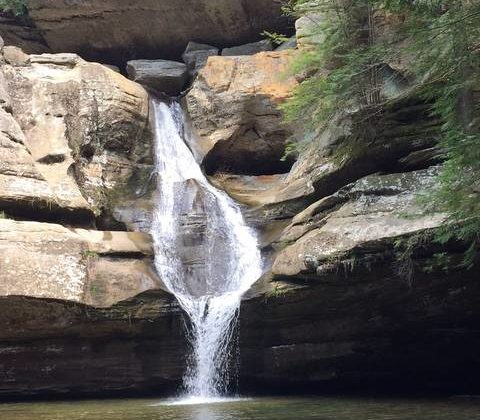
By Jane Beathard

To scientists, they are a way to study the many layers of rock that tell Ohio’s geologic history.
To Native Americans, they were sacred places to gather for ceremonies and connect with the spirit world.
To outdoor enthusiasts, they offer retreat, reflection and elusive natural beauty.
Whatever the draw, Ohio’s waterfalls continue to attract and fascinate visitors — just as they have for hundreds of years.
They also dispute the widespread assumption that Ohio is flat and without natural features. Some Ohio waterfalls rise as high as 90 feet, according to assistant state geologist Mike Angle.
East versus west
Although a few notable waterfalls are found in southwestern Ohio, the most dramatic occur in the east, Angle said.
The reason is geologic and dates back millions of years to when the Buckeye State was covered by a shallow sea.
Sea waters retreated, leaving layers of hard sandstone over softer shale rock in what is now the eastern portion of the state.
“The western half is mostly (thick) limestone,” Angle said. “These rocks are more uniform and there’s less difference in hardness there.”
Water from melting northern glaciers created rivers that cut through the hard and soft rock layers in the east, causing them to erode at different paces, he added.
The result were places where water fell over a “lip” of hard rock and chewed away the soft rock below. Today, that is most visible where bedrock from Ohio’s different geologic eras overlap.
In the northeast, overlap is most noticeable in southern Cuyahoga and northern Summit counties, as well as portions of Lorain, Huron, Richland and Ashland counties. There, Berea and Sharon Sandstone form the hard upper lip or ledge of waterfalls.
In the southeast, Black Hand Sandstone is the lip and occurs most noticeably in Muskingum, Perry, Hocking and Vinton counties.
To a lesser extent, an overlap of different and older rock layers also occurs in Greene and Miami counties in the southwest, Angle added.
Today’s geologists love to study waterfalls across the state.
“They can see the different rock levels and degrees of hardness,” Angle said.
Wild Hocking Hills
Ohio’s Black Hand Delta is a narrow finger of sandstone that extends northward from the Ohio River to about Wayne County and totally encompasses Hocking County.
The Hocking Hills are home to some of Ohio’s most spectacular waterfalls, said Pat Quackenbush, chief naturalist at Hocking Hills State Park.
He attributes unusual contortions of water over rock for the unique visual appeal of the falls at Old Man’s Cave, Ash Cave and Cedar Falls in the park.
Native Americans were the first to visit these falls, starting about 6,000 years ago. And like visitors of today, they often came for spiritual renewal.
“They didn’t live here, but came to hunt and hold ceremonies,” Quackenbush said.
One legend says the Ash Cave falls, that plunge 90 feet from rim to pool, came from the tears of a native woman widowed when her warrior husband was killed in battle.
It’s the lore and wildness that continue to lure more than 2 million visitors to the park annually.
Something ‘magic’
“There’s something magic about a waterfall,” observed Tom Arbour, a researcher with Ohio State Parks & Watercraft.
Waterfalls draw thousands of visitors each year to state parks and nature preserves. Arbour believes that popularity stems from the ephemeral nature of Ohio’s cascades. Most run high following spring rains, but dwindle to a trickle and nearly disappear in the fall.
“They are not there all the time,” Arbour said.
Elusiveness is not the only attraction.
“The more mysterious and hidden the waterfall, the bigger the draw,” he added.
Evidence of that theory is newly acquired Robinson Falls at Boch Hollow State Nature Preserve in the northern Hocking Hills.
“It’s currently showing the biggest interest among photographers,” Arbour said.
Access to Boch Hollow is by permit only. But that deters few who are intent on capturing images of the falls.
“It opened our minds to how popular waterfalls are,” Arbour said.
That interest can come with an element of danger to both the viewer and the delicate plants that thrive around these natural features.
Three years ago, a woman died after falling into Greenville Falls in Miami County, Arbour noted.
“We’re seeing more people go ‘off trail’ to view and photograph waterfalls,” he said.
Arbour pointed to photographs posted on the Ohio waterfalls Facebook page as evidence. Some required the photographers to be in places that are clearly off limits and hazardous to foot traffic.
His message to future visitors is enjoy the state’s waterfalls, but stick to the marked trails for safety.
ID, 'source', true); $sourcelink = get_post_meta($post->ID, 'sourcelink', true); $sourcestring = '' . __('SOURCE','gabfire') . ''; if ($sourcelink != '') { echo "
$sourcestring: $source
"; } elseif ($source != '') { echo "$sourcestring: $source
"; } // Display pagination $args = array( 'before' => '' . __('Pages:','gabfire'), 'after' => '
', 'link_before' => '', 'link_after' => '', 'next_or_number' => 'number', 'nextpagelink' => __('Next page', 'gabfire'), 'previouspagelink' => __('Previous page', 'gabfire'), 'pagelink' => '%', 'echo' => 1 ); wp_link_pages($args); // Display edit post link to site admin edit_post_link(__('Edit','gabfire'),'','
'); // Post Widget gab_dynamic_sidebar('PostWidget'); ?>